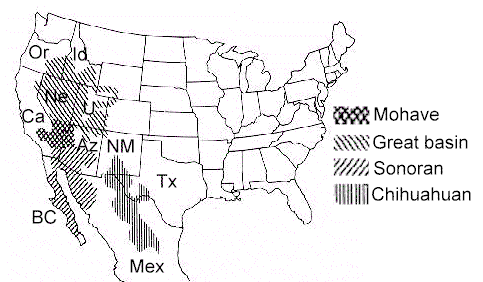| The
deserts of North America The
North American deserts are highly accessible,
well-researched and very diverse, so they provide a good
basis for understanding desert ecology. These deserts are
found in a broad band running down the western side of
the USA and into Mexico. They lie in a large basin
between the Rocky Mountains to the east and the Sierra
Nevada to the west. They receive relatively little water
- typically less than 25 cm (10 inches) per year -
because most of the precipitation falls on the higher
mountain ranges and not in the lower-lying desert regions
(which are in the "rain shadow" of the
mountains).

Approximate boundaries of the four main
deserts of North America
These North American deserts are grouped into four
major types - the Great Basin Desert, Sonoran
Desert, Chihuahuan Desert and Mojave
Desert - depending on their characteristic physical
features (rainfall, topography, soil types) and
characteristic vegetation and associated animal
communities.
- The Great
Basin Desert is the largest
desert area of North America. It is also the most
northerly, covering most of Nevada (Ne), the
western third of Utah (U) and parts of Idaho (Id)
and Oregon (Or). It is a cold desert because of
its northerly location and its relatively high
altitude - most of the land lies above 1200
metres (4000 ft), but in the 'rain shadow' of the
higher mountain ranges. Much of the precipitation
occurs as winter snowfall, but not all of this
melts into the ground because some of it
evaporates in spring. The vegetation tends to be
very uniform over large areas of this desert. It
is dominated by various types of sagebrush,
or by saltbush
where the soil has a high salt concentration. In
fact, the soils often have a high salt content
(sodium and calcium ions) caused by evaporation
of water in the hot summer months, and no
vegetation can grow in the saltiest regions.
- The Mojave
Desert occurs further south
and covers the southern part of Nevada and part
of California (Ca) but elements of it extend into
Arizona (Az) where it blends into the Sonoran
Desert. Again, it is classed as a cold desert
because of the low winter temperatures. The
precipitation occurs in winter, usually as rain
but sometimes as snow at the higher elevations.
The features of the Mohave Desert are difficult
to define because of the marked variation in
topography, soils and climate. For example, the
northern section is composed of low-growing
shrubs, similar to those of the Great Basin
Desert, whereas the southern section blends into
the Sonoran Desert, with extensive tracts of
creosote bush. The Mohave Desert includes Death
Valley - the lowest (below sea level) and driest
of all desert regions, where there may be no rain
for several years. The Majove Desert contains
some highly characteristic plants and animals -
most notably the joshua
tree at higher elevations.
- The Sonoran
Desert covers the southern
part of Arizona and part of California, but
extends south into the mainland of Mexico and
into the extended isthmus of the state of Baja
California (BC) in Mexico. The Sonoran Desert is
a hot desert and, unlike all the other desert
regions of North America, it receives both winter
and summer rains. This pattern of rainfall is
caused by the seasonal shifts of major storm
tracks across the USA. The Sonoran Desert
receives winter rainfall from moisture-laden air
carried on winds from the Pacific Ocean, and
summer rainfall from air carried northwestwards
from the Gulf of Mexico. As a consequence, parts
of the Sonoran Desert can support unusually lush
vegetation, including several trees and
sub-trees, and some very large cacti such as the saguaro
and cardon.
The Baja
California peninsula of Mexico is
also included in the Sonoran Desert, but the
west-facing slopes of this peninsula receive
moisture-laden air from the Pacific Ocean and
have some uniquely lush vegetation, including epiphytic plants
that gain their moisture from the sea mists.
- The Chihuahuan
Desert occupies the extreme
west of Texas (Tx) and part of New Mexico (NM),
but the largest part of this desert occurs in
mainland Mexico. This desert region receives
summer rains from the Gulf of Mexico - typically
about 20-30 cm per year. Over much of this desert
the soils are derived from calcareous rocks and
thus have relatively high pH. The Chihuahuan
Desert also lies at relatively high elevation
(typically about 1200 metres, or 4000 ft) and
thus has cool winters with periodic frosts, but
the summers are hot. The combination of
relatively high rainfall, calcareous soils and
cool winter temperatures favours the growth of
grasses, yuccas
and agaves.
There are many small
cacti, but few of the larger cacti
associated with the Sonoran Desert.
Whilst some of the best desert areas of
North America are now protected from development by being
designated as State Parks, National Parks or National
Monuments, vast areas of land dominated by creosote bush
and other less spectacular vegetation are now been used
for irrigated agriculture, drawing water from major
rivers. When irrigated, these desert can be phenomenally
productive because of their year-round warmth and solar
intensity.
|
